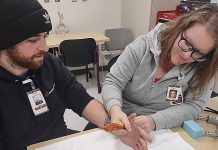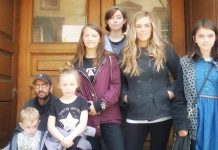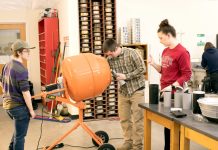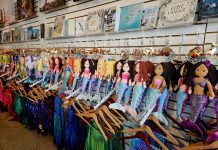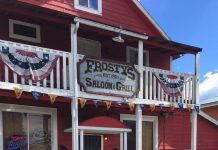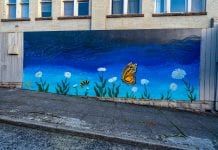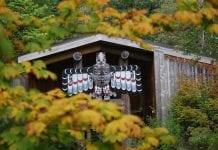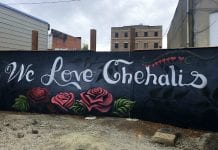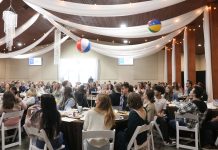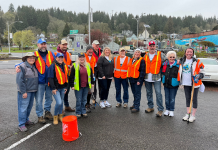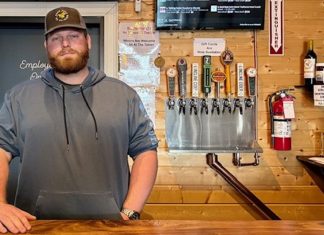Sometimes when you visit a museum, it can be overwhelming. Which display or artifact do you look at first? Can you narrow things down? Sometimes it helps to just focus on a few things at a time. So for this visit to the Lewis County Historical Museum, we chose to focus on looking for the oldest, newest, smallest and largest artifacts.
Oldest
While there are undated rocks and stone tool exhibits, the oldest dated artifact on display is a beautiful violin that was made in 1849. We know this because the story is that it was given to someone in 1849, who took it to California during the Gold Rush. At some point it made its way up to Lewis County to its final resting place at the museum. Its rich warm wood and smooth curves still convey the love that was put into the crafting of the violin. And that love was passed on to the owner or owners who protected and cared for it during all those years.

Newest
The newest, or most modern, artifact is a Coolpix digital camera, which is part of the photography display that shows the progression of cameras over the years. Interestingly, it sits near a 1930s era Universal Camera Corporation “Aristocrat” camera that is basically the same size as the modern Coolpix. Maybe the size and convenience of the newer cameras isn’t so innovative after all.

Smallest
The smallest artifact is quite tiny. It is a set of what are called “Collar-Bobs” from the 1930s. They are tiny pins about the size of post earrings that were used to hold down the ends of collars on a dress shirt. On today’s shirts you may see small buttons used instead. The Collar-Bobs are something you will likely only see in a museum or in a private estate, as the internet world knows nothing about them. They don’t show up on any search engine.
Largest
The largest artifact is a very new donation to the museum. It’s an old buggy, known as a “Hack.” The City of Centralia had it in storage for many years before donating it. It’s located in the back area of the museum, across from the model train display, and was built in 1880. “They always painted the date under the seat,” explains Ted Livermore, President of Lewis County Model Railroad Club and history buff.
 “It was the limousine of the time period,” says Jason Mattson, Museum Director. “The Hack was owned by Sticklin Funeral Home and used to transport the families of the deceased. It’s known as the Deacon’s Coach.”
“It was the limousine of the time period,” says Jason Mattson, Museum Director. “The Hack was owned by Sticklin Funeral Home and used to transport the families of the deceased. It’s known as the Deacon’s Coach.”
While the Hack has deteriorated quite a bit over the years, you can still see many fine details on it. Red pin-striping on the wood, beveled glass windows, lantern hooks attached to the side. “It would be great if we could get lanterns to hang on the hooks,” smiles Livermore.
For many years, before the museum received the Hack, the largest artifact was another buggy, a 1916 Spring Buggy. It has been located inside the building on top of one of the faux buildings. Spring buggies became a primary source of transportation for many people, as horses became more expensive and buggies became more affordable.
Buggies were not in use as long as one might think. In America, it was only for about 50 years as there weren’t many roads to ride on. Then cars came along. Ironically, while cars normally make traffic move faster in most places, according to an article called, “Introduction: Transportation in America and the Carriage Age” from the Park City Museum in Utah, “In a New York City traffic study undertaken in 1907, horse-drawn vehicles moved at an average speed of 11.5 m.p.h. A similar study conducted almost 60 years later found that automobiles moved through the city’s business district at an average speed of only 8.5 m.p.h.” Ironically, modern ideas don’t always make things better and faster.

The Argument
An argument could be made that the largest, newest and smallest artifacts are actually in one display – the model railroad. The Lewis County Model Railroad Club meets at the museum on Friday afternoons from 3:00 p.m. to 7:00 p.m. Members are constantly expanding and adding to the display. The exhibit portrays Lewis County in the 1970s.
Either way, it’s always interesting to go to a museum and see all the artifacts on display. But the next time you go, have a particular item or time period in mind. Go on a scavenger hunt looking for those items. Exhibits can be changed over at any time and some of these items may not be on display when you go. So just go back often, see what has changed and enjoy this new way of exploring a museum.
Lewis County Historical Museum
599 NW Front St.
Chehalis WA 98532
360-748-8031



